Leadership and Management Scenario: Analysis and Strategies
VerifiedAdded on 2020/03/16
|9
|1636
|62
Report
AI Summary
This report presents an in-depth analysis of a leadership and management scenario, addressing various facets of organizational effectiveness. It begins by outlining communication strategies, emphasizing the importance of clear objectives and considering factors such as political, economic, social, and technical influences. The report then delves into risk management, including hazard identification and mitigation strategies, as well as the importance of adhering to relevant legislations like the Fair Work Act. Furthermore, it explores the significance of building trust, adopting transformational leadership styles, and effective delegation. The report also includes a training needs analysis, identifying skill gaps and proposing development plans. Additionally, it highlights the roles of team leaders and administrative assistants, as well as the benefits of professional development and business networking. Overall, the report offers practical insights into managing workplace challenges and fostering a productive environment.
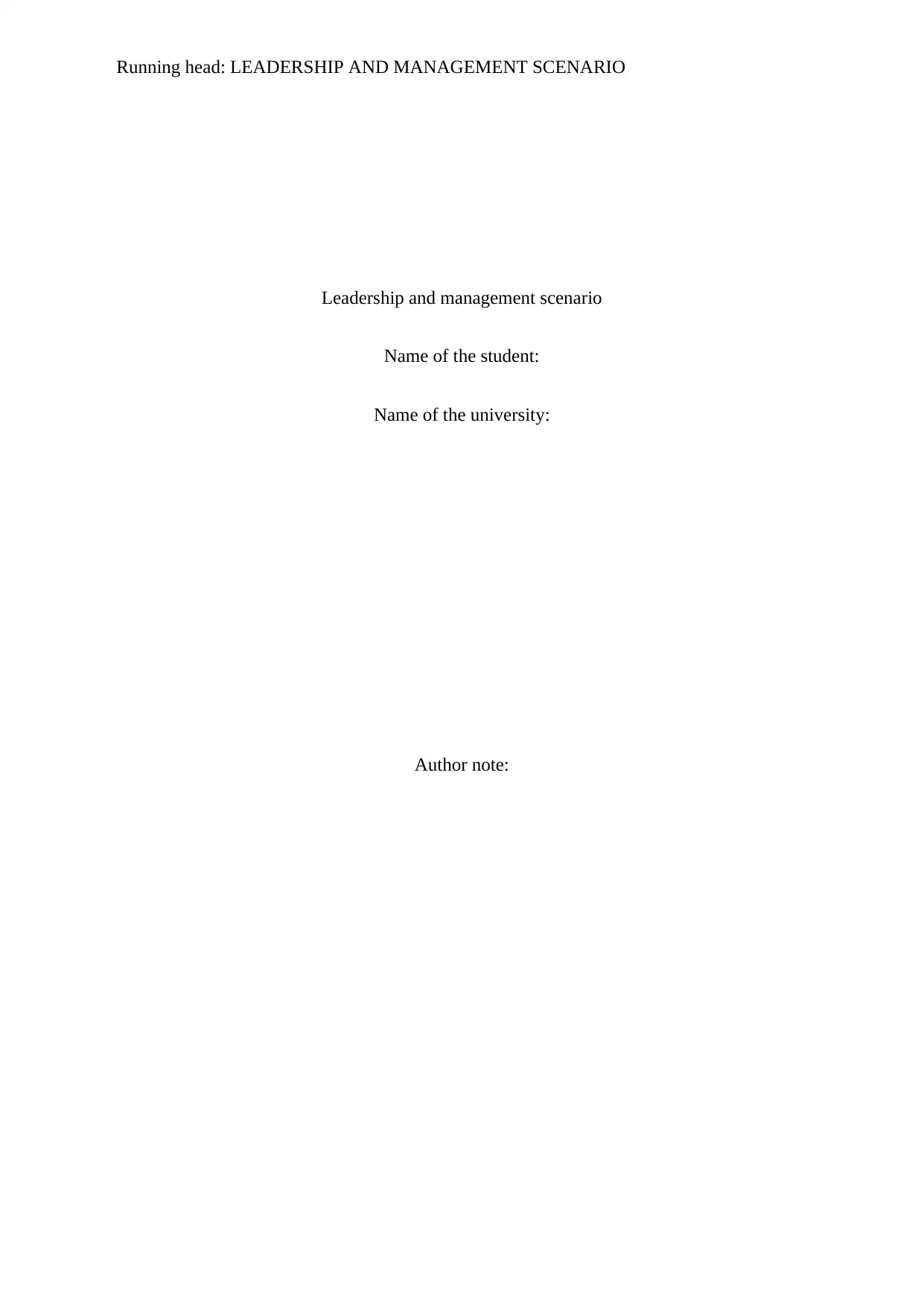
Running head: LEADERSHIP AND MANAGEMENT SCENARIO
Leadership and management scenario
Name of the student:
Name of the university:
Author note:
Leadership and management scenario
Name of the student:
Name of the university:
Author note:
Paraphrase This Document
Need a fresh take? Get an instant paraphrase of this document with our AI Paraphraser
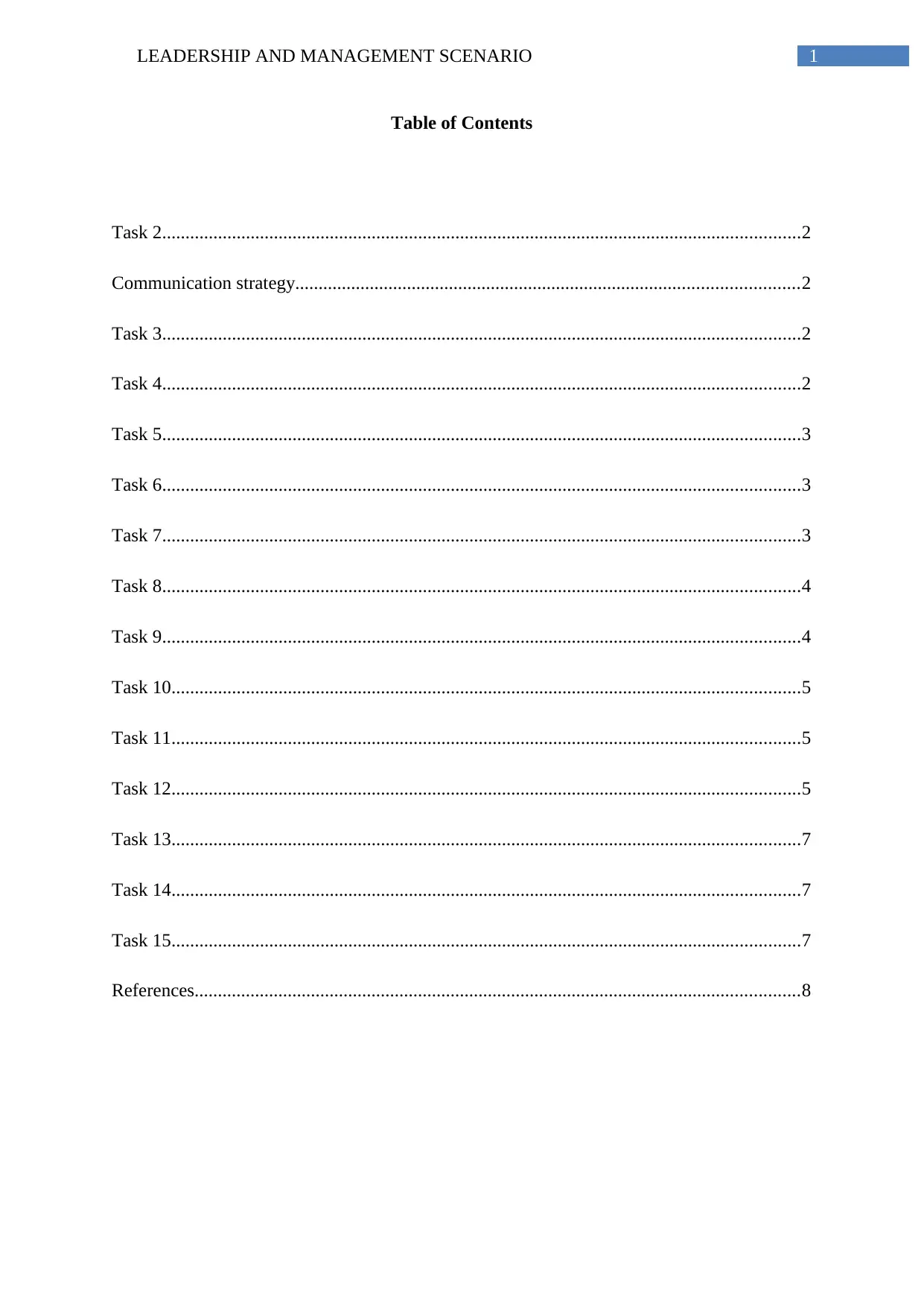
1LEADERSHIP AND MANAGEMENT SCENARIO
Table of Contents
Task 2.........................................................................................................................................2
Communication strategy............................................................................................................2
Task 3.........................................................................................................................................2
Task 4.........................................................................................................................................2
Task 5.........................................................................................................................................3
Task 6.........................................................................................................................................3
Task 7.........................................................................................................................................3
Task 8.........................................................................................................................................4
Task 9.........................................................................................................................................4
Task 10.......................................................................................................................................5
Task 11.......................................................................................................................................5
Task 12.......................................................................................................................................5
Task 13.......................................................................................................................................7
Task 14.......................................................................................................................................7
Task 15.......................................................................................................................................7
References..................................................................................................................................8
Table of Contents
Task 2.........................................................................................................................................2
Communication strategy............................................................................................................2
Task 3.........................................................................................................................................2
Task 4.........................................................................................................................................2
Task 5.........................................................................................................................................3
Task 6.........................................................................................................................................3
Task 7.........................................................................................................................................3
Task 8.........................................................................................................................................4
Task 9.........................................................................................................................................4
Task 10.......................................................................................................................................5
Task 11.......................................................................................................................................5
Task 12.......................................................................................................................................5
Task 13.......................................................................................................................................7
Task 14.......................................................................................................................................7
Task 15.......................................................................................................................................7
References..................................................................................................................................8
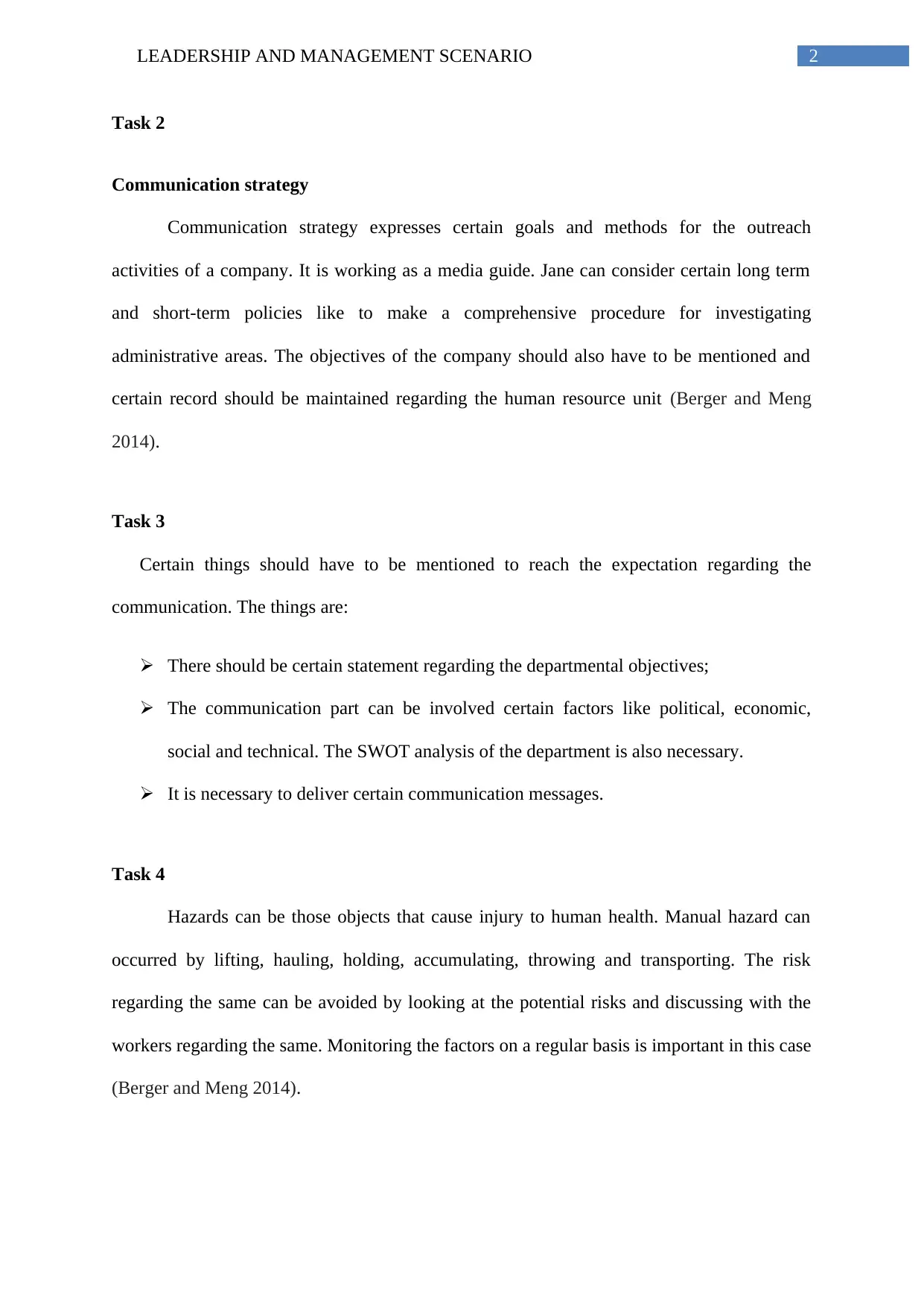
2LEADERSHIP AND MANAGEMENT SCENARIO
Task 2
Communication strategy
Communication strategy expresses certain goals and methods for the outreach
activities of a company. It is working as a media guide. Jane can consider certain long term
and short-term policies like to make a comprehensive procedure for investigating
administrative areas. The objectives of the company should also have to be mentioned and
certain record should be maintained regarding the human resource unit (Berger and Meng
2014).
Task 3
Certain things should have to be mentioned to reach the expectation regarding the
communication. The things are:
There should be certain statement regarding the departmental objectives;
The communication part can be involved certain factors like political, economic,
social and technical. The SWOT analysis of the department is also necessary.
It is necessary to deliver certain communication messages.
Task 4
Hazards can be those objects that cause injury to human health. Manual hazard can
occurred by lifting, hauling, holding, accumulating, throwing and transporting. The risk
regarding the same can be avoided by looking at the potential risks and discussing with the
workers regarding the same. Monitoring the factors on a regular basis is important in this case
(Berger and Meng 2014).
Task 2
Communication strategy
Communication strategy expresses certain goals and methods for the outreach
activities of a company. It is working as a media guide. Jane can consider certain long term
and short-term policies like to make a comprehensive procedure for investigating
administrative areas. The objectives of the company should also have to be mentioned and
certain record should be maintained regarding the human resource unit (Berger and Meng
2014).
Task 3
Certain things should have to be mentioned to reach the expectation regarding the
communication. The things are:
There should be certain statement regarding the departmental objectives;
The communication part can be involved certain factors like political, economic,
social and technical. The SWOT analysis of the department is also necessary.
It is necessary to deliver certain communication messages.
Task 4
Hazards can be those objects that cause injury to human health. Manual hazard can
occurred by lifting, hauling, holding, accumulating, throwing and transporting. The risk
regarding the same can be avoided by looking at the potential risks and discussing with the
workers regarding the same. Monitoring the factors on a regular basis is important in this case
(Berger and Meng 2014).
⊘ This is a preview!⊘
Do you want full access?
Subscribe today to unlock all pages.

Trusted by 1+ million students worldwide
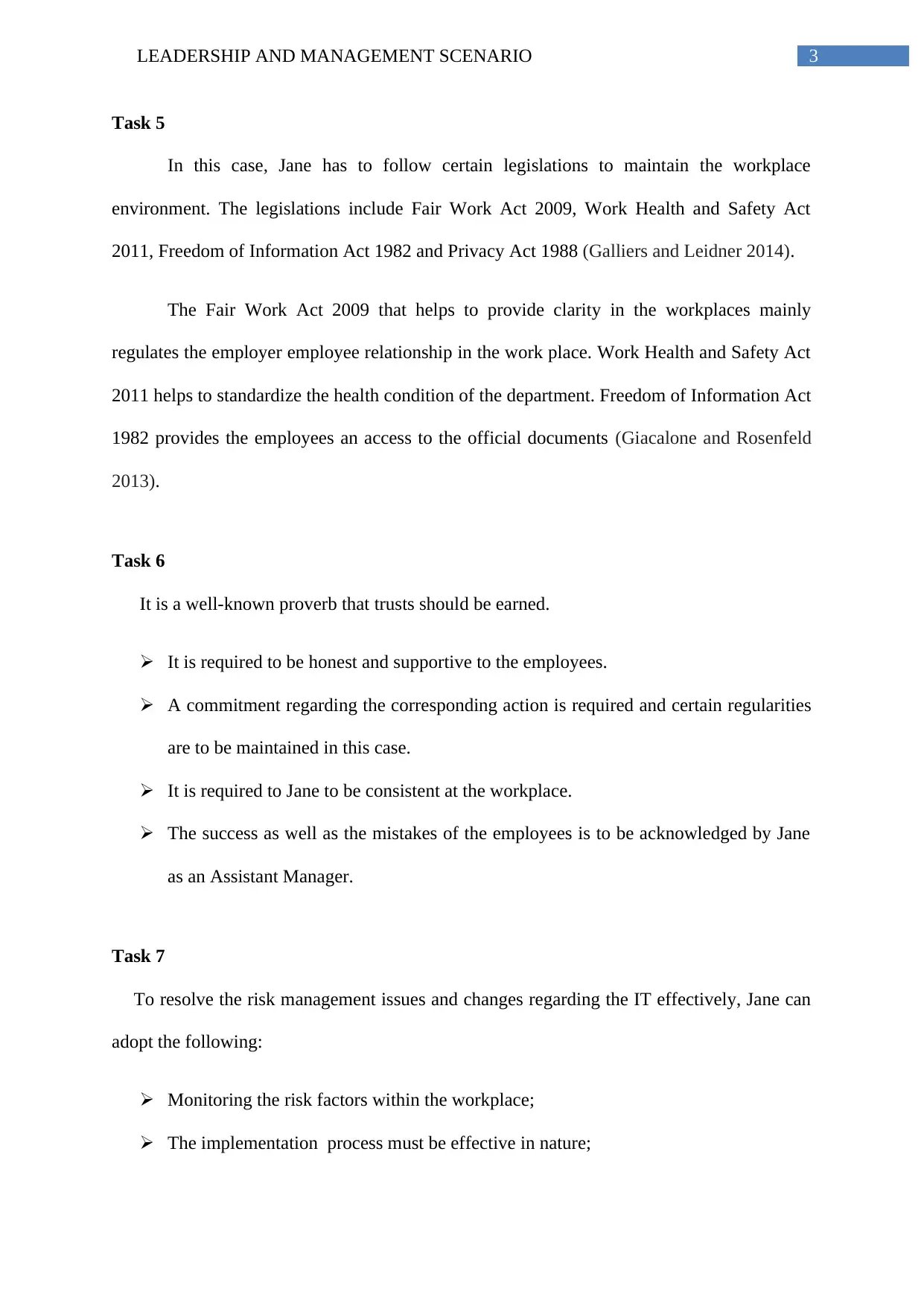
3LEADERSHIP AND MANAGEMENT SCENARIO
Task 5
In this case, Jane has to follow certain legislations to maintain the workplace
environment. The legislations include Fair Work Act 2009, Work Health and Safety Act
2011, Freedom of Information Act 1982 and Privacy Act 1988 (Galliers and Leidner 2014).
The Fair Work Act 2009 that helps to provide clarity in the workplaces mainly
regulates the employer employee relationship in the work place. Work Health and Safety Act
2011 helps to standardize the health condition of the department. Freedom of Information Act
1982 provides the employees an access to the official documents (Giacalone and Rosenfeld
2013).
Task 6
It is a well-known proverb that trusts should be earned.
It is required to be honest and supportive to the employees.
A commitment regarding the corresponding action is required and certain regularities
are to be maintained in this case.
It is required to Jane to be consistent at the workplace.
The success as well as the mistakes of the employees is to be acknowledged by Jane
as an Assistant Manager.
Task 7
To resolve the risk management issues and changes regarding the IT effectively, Jane can
adopt the following:
Monitoring the risk factors within the workplace;
The implementation process must be effective in nature;
Task 5
In this case, Jane has to follow certain legislations to maintain the workplace
environment. The legislations include Fair Work Act 2009, Work Health and Safety Act
2011, Freedom of Information Act 1982 and Privacy Act 1988 (Galliers and Leidner 2014).
The Fair Work Act 2009 that helps to provide clarity in the workplaces mainly
regulates the employer employee relationship in the work place. Work Health and Safety Act
2011 helps to standardize the health condition of the department. Freedom of Information Act
1982 provides the employees an access to the official documents (Giacalone and Rosenfeld
2013).
Task 6
It is a well-known proverb that trusts should be earned.
It is required to be honest and supportive to the employees.
A commitment regarding the corresponding action is required and certain regularities
are to be maintained in this case.
It is required to Jane to be consistent at the workplace.
The success as well as the mistakes of the employees is to be acknowledged by Jane
as an Assistant Manager.
Task 7
To resolve the risk management issues and changes regarding the IT effectively, Jane can
adopt the following:
Monitoring the risk factors within the workplace;
The implementation process must be effective in nature;
Paraphrase This Document
Need a fresh take? Get an instant paraphrase of this document with our AI Paraphraser
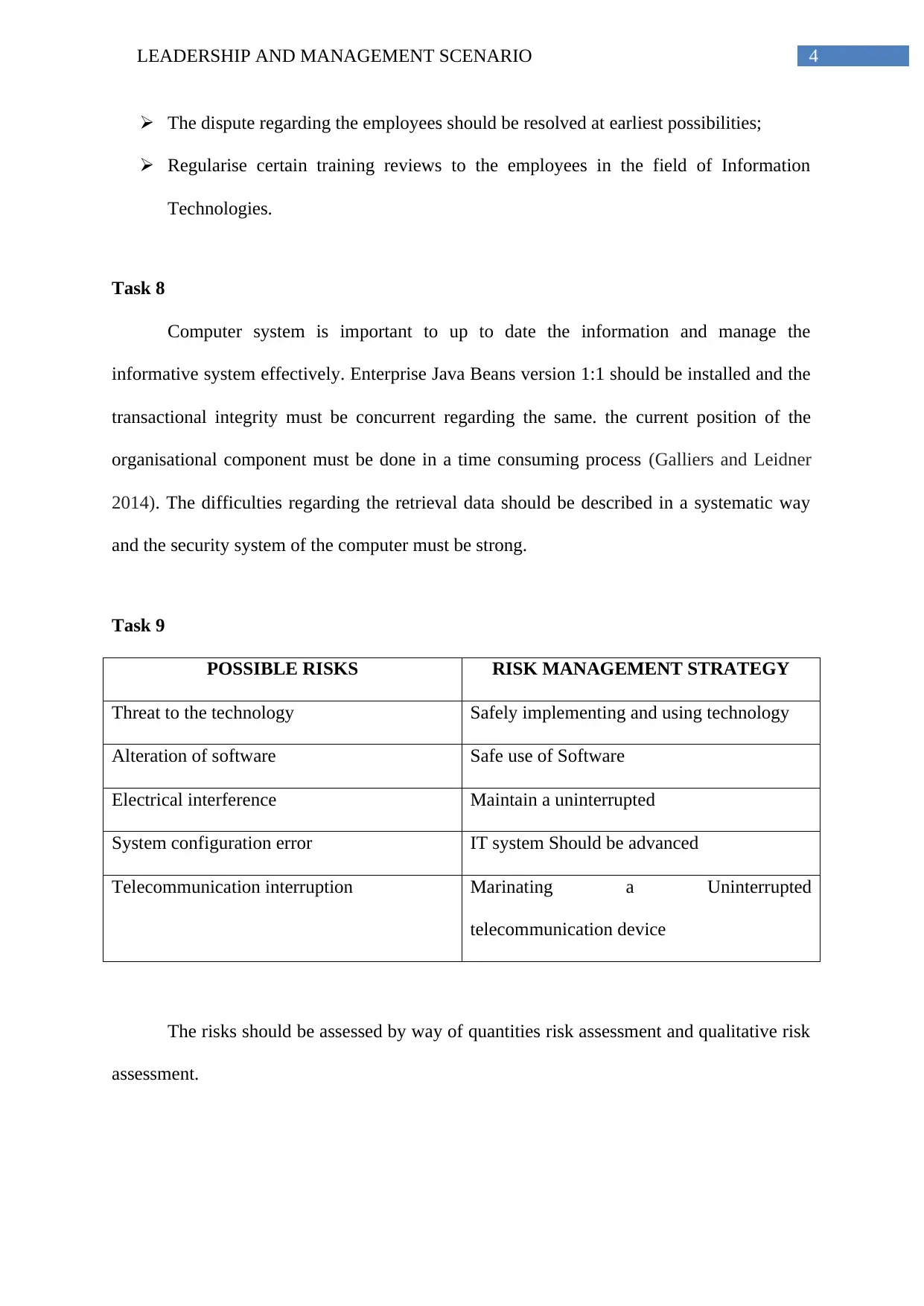
4LEADERSHIP AND MANAGEMENT SCENARIO
The dispute regarding the employees should be resolved at earliest possibilities;
Regularise certain training reviews to the employees in the field of Information
Technologies.
Task 8
Computer system is important to up to date the information and manage the
informative system effectively. Enterprise Java Beans version 1:1 should be installed and the
transactional integrity must be concurrent regarding the same. the current position of the
organisational component must be done in a time consuming process (Galliers and Leidner
2014). The difficulties regarding the retrieval data should be described in a systematic way
and the security system of the computer must be strong.
Task 9
POSSIBLE RISKS RISK MANAGEMENT STRATEGY
Threat to the technology Safely implementing and using technology
Alteration of software Safe use of Software
Electrical interference Maintain a uninterrupted
System configuration error IT system Should be advanced
Telecommunication interruption Marinating a Uninterrupted
telecommunication device
The risks should be assessed by way of quantities risk assessment and qualitative risk
assessment.
The dispute regarding the employees should be resolved at earliest possibilities;
Regularise certain training reviews to the employees in the field of Information
Technologies.
Task 8
Computer system is important to up to date the information and manage the
informative system effectively. Enterprise Java Beans version 1:1 should be installed and the
transactional integrity must be concurrent regarding the same. the current position of the
organisational component must be done in a time consuming process (Galliers and Leidner
2014). The difficulties regarding the retrieval data should be described in a systematic way
and the security system of the computer must be strong.
Task 9
POSSIBLE RISKS RISK MANAGEMENT STRATEGY
Threat to the technology Safely implementing and using technology
Alteration of software Safe use of Software
Electrical interference Maintain a uninterrupted
System configuration error IT system Should be advanced
Telecommunication interruption Marinating a Uninterrupted
telecommunication device
The risks should be assessed by way of quantities risk assessment and qualitative risk
assessment.
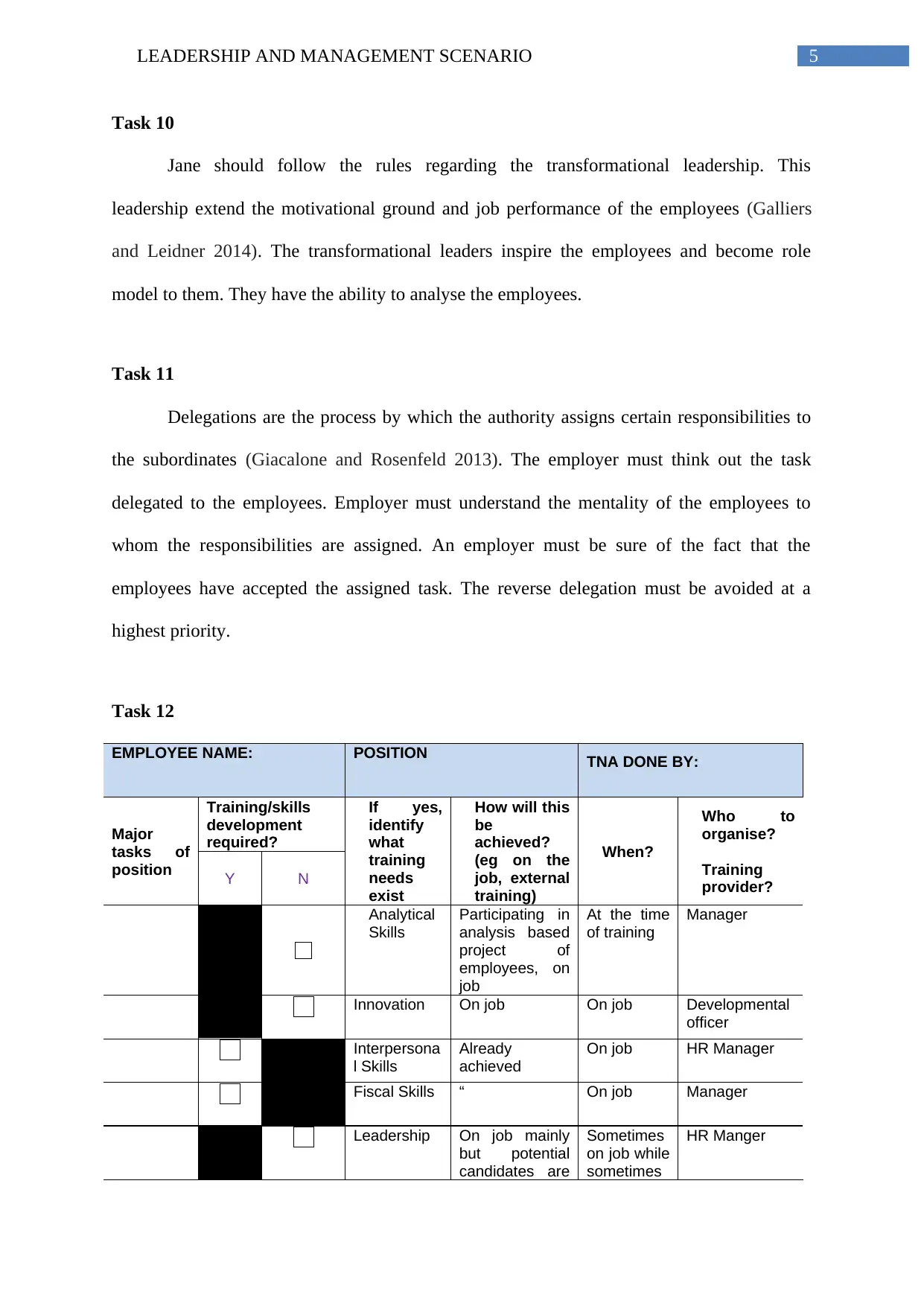
5LEADERSHIP AND MANAGEMENT SCENARIO
Task 10
Jane should follow the rules regarding the transformational leadership. This
leadership extend the motivational ground and job performance of the employees (Galliers
and Leidner 2014). The transformational leaders inspire the employees and become role
model to them. They have the ability to analyse the employees.
Task 11
Delegations are the process by which the authority assigns certain responsibilities to
the subordinates (Giacalone and Rosenfeld 2013). The employer must think out the task
delegated to the employees. Employer must understand the mentality of the employees to
whom the responsibilities are assigned. An employer must be sure of the fact that the
employees have accepted the assigned task. The reverse delegation must be avoided at a
highest priority.
Task 12
EMPLOYEE NAME: POSITION TNA DONE BY:
Major
tasks of
position
Training/skills
development
required?
If yes,
identify
what
training
needs
exist
How will this
be
achieved?
(eg on the
job, external
training)
When?
Who to
organise?
Training
provider?
Y N
Analytical
Skills
Participating in
analysis based
project of
employees, on
job
At the time
of training
Manager
Innovation On job On job Developmental
officer
Interpersona
l Skills
Already
achieved
On job HR Manager
Fiscal Skills “ On job Manager
Leadership On job mainly
but potential
candidates are
Sometimes
on job while
sometimes
HR Manger
Task 10
Jane should follow the rules regarding the transformational leadership. This
leadership extend the motivational ground and job performance of the employees (Galliers
and Leidner 2014). The transformational leaders inspire the employees and become role
model to them. They have the ability to analyse the employees.
Task 11
Delegations are the process by which the authority assigns certain responsibilities to
the subordinates (Giacalone and Rosenfeld 2013). The employer must think out the task
delegated to the employees. Employer must understand the mentality of the employees to
whom the responsibilities are assigned. An employer must be sure of the fact that the
employees have accepted the assigned task. The reverse delegation must be avoided at a
highest priority.
Task 12
EMPLOYEE NAME: POSITION TNA DONE BY:
Major
tasks of
position
Training/skills
development
required?
If yes,
identify
what
training
needs
exist
How will this
be
achieved?
(eg on the
job, external
training)
When?
Who to
organise?
Training
provider?
Y N
Analytical
Skills
Participating in
analysis based
project of
employees, on
job
At the time
of training
Manager
Innovation On job On job Developmental
officer
Interpersona
l Skills
Already
achieved
On job HR Manager
Fiscal Skills “ On job Manager
Leadership On job mainly
but potential
candidates are
Sometimes
on job while
sometimes
HR Manger
⊘ This is a preview!⊘
Do you want full access?
Subscribe today to unlock all pages.

Trusted by 1+ million students worldwide
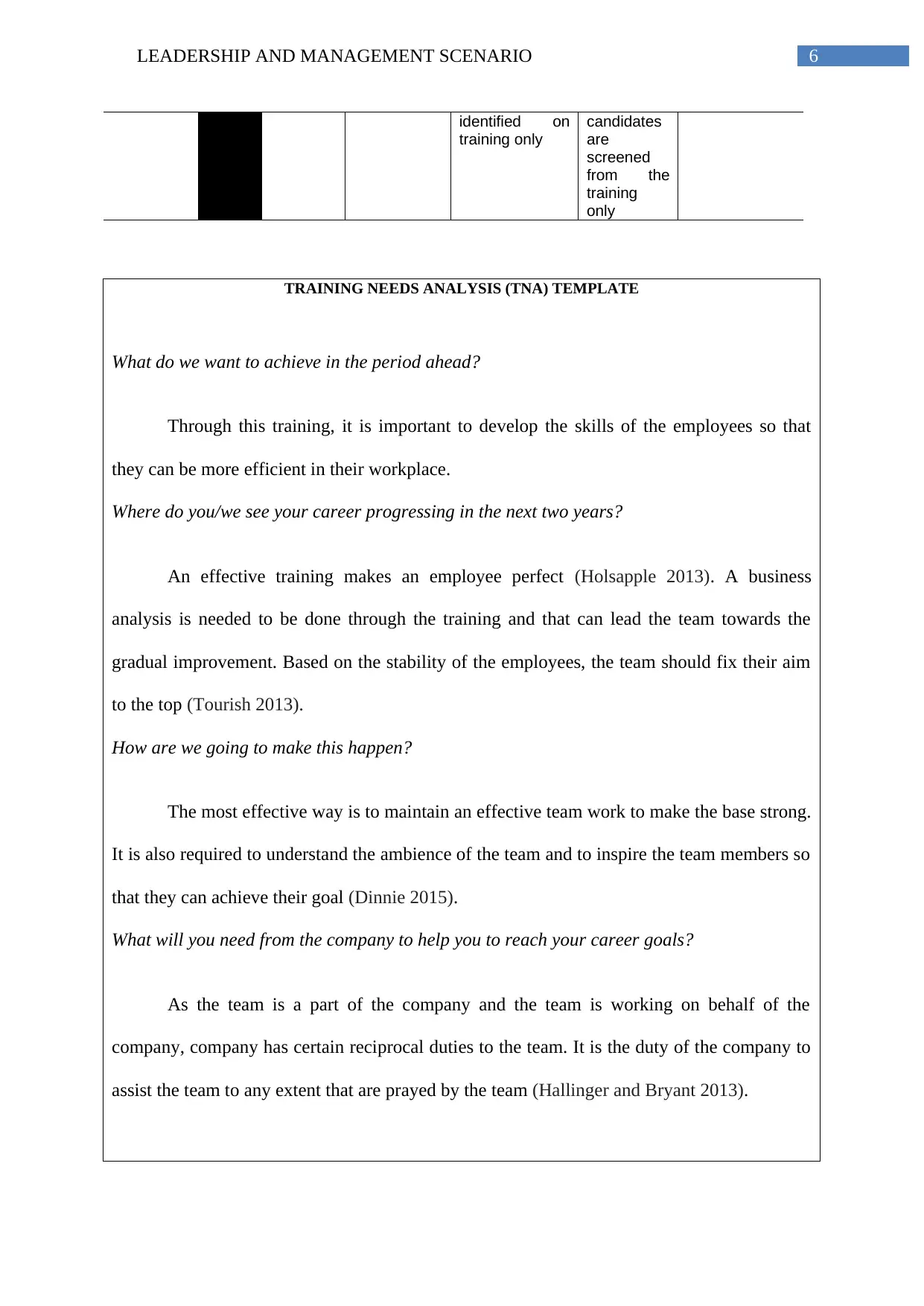
6LEADERSHIP AND MANAGEMENT SCENARIO
identified on
training only
candidates
are
screened
from the
training
only
TRAINING NEEDS ANALYSIS (TNA) TEMPLATE
What do we want to achieve in the period ahead?
Through this training, it is important to develop the skills of the employees so that
they can be more efficient in their workplace.
Where do you/we see your career progressing in the next two years?
An effective training makes an employee perfect (Holsapple 2013). A business
analysis is needed to be done through the training and that can lead the team towards the
gradual improvement. Based on the stability of the employees, the team should fix their aim
to the top (Tourish 2013).
How are we going to make this happen?
The most effective way is to maintain an effective team work to make the base strong.
It is also required to understand the ambience of the team and to inspire the team members so
that they can achieve their goal (Dinnie 2015).
What will you need from the company to help you to reach your career goals?
As the team is a part of the company and the team is working on behalf of the
company, company has certain reciprocal duties to the team. It is the duty of the company to
assist the team to any extent that are prayed by the team (Hallinger and Bryant 2013).
identified on
training only
candidates
are
screened
from the
training
only
TRAINING NEEDS ANALYSIS (TNA) TEMPLATE
What do we want to achieve in the period ahead?
Through this training, it is important to develop the skills of the employees so that
they can be more efficient in their workplace.
Where do you/we see your career progressing in the next two years?
An effective training makes an employee perfect (Holsapple 2013). A business
analysis is needed to be done through the training and that can lead the team towards the
gradual improvement. Based on the stability of the employees, the team should fix their aim
to the top (Tourish 2013).
How are we going to make this happen?
The most effective way is to maintain an effective team work to make the base strong.
It is also required to understand the ambience of the team and to inspire the team members so
that they can achieve their goal (Dinnie 2015).
What will you need from the company to help you to reach your career goals?
As the team is a part of the company and the team is working on behalf of the
company, company has certain reciprocal duties to the team. It is the duty of the company to
assist the team to any extent that are prayed by the team (Hallinger and Bryant 2013).
Paraphrase This Document
Need a fresh take? Get an instant paraphrase of this document with our AI Paraphraser
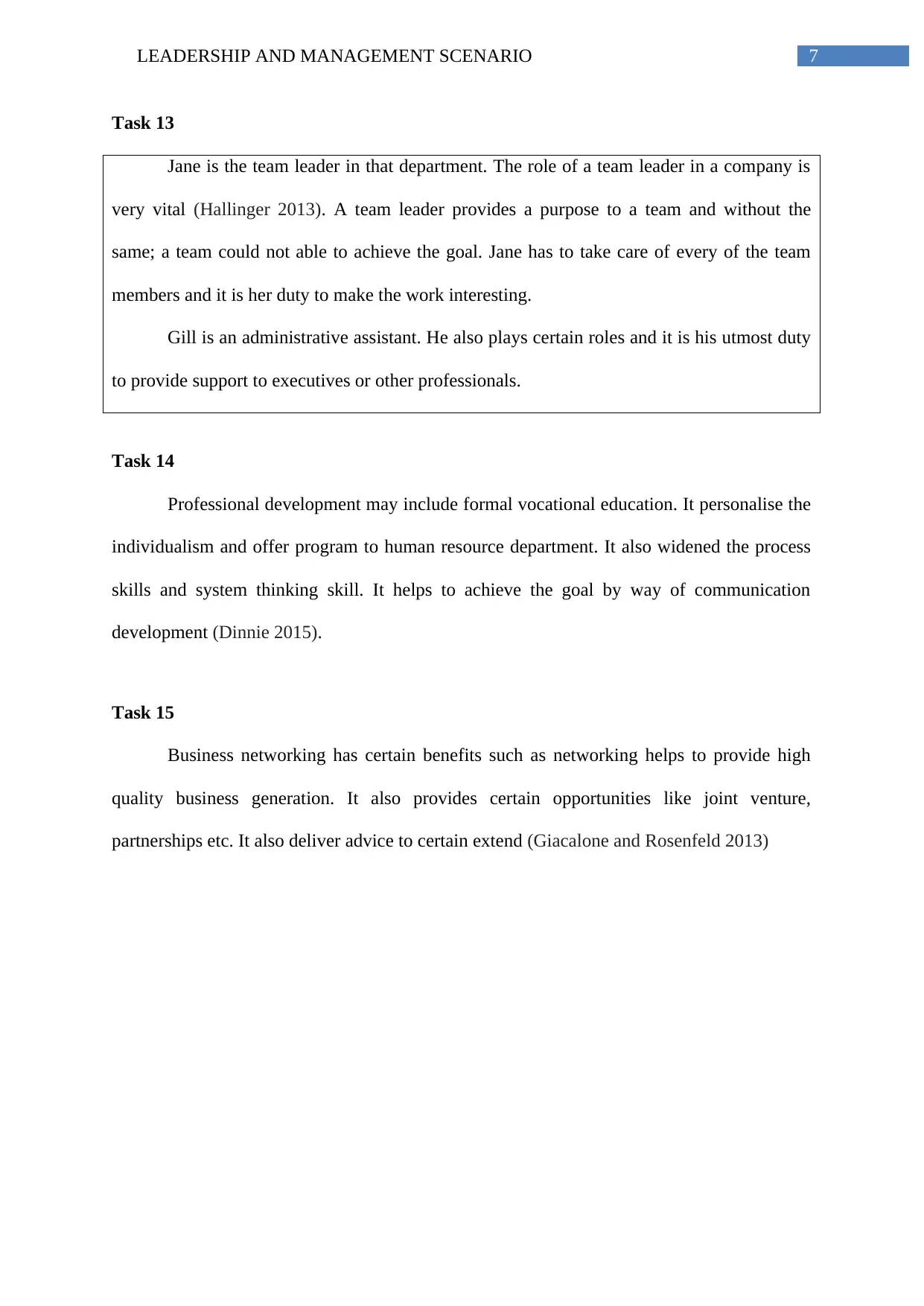
7LEADERSHIP AND MANAGEMENT SCENARIO
Task 13
Jane is the team leader in that department. The role of a team leader in a company is
very vital (Hallinger 2013). A team leader provides a purpose to a team and without the
same; a team could not able to achieve the goal. Jane has to take care of every of the team
members and it is her duty to make the work interesting.
Gill is an administrative assistant. He also plays certain roles and it is his utmost duty
to provide support to executives or other professionals.
Task 14
Professional development may include formal vocational education. It personalise the
individualism and offer program to human resource department. It also widened the process
skills and system thinking skill. It helps to achieve the goal by way of communication
development (Dinnie 2015).
Task 15
Business networking has certain benefits such as networking helps to provide high
quality business generation. It also provides certain opportunities like joint venture,
partnerships etc. It also deliver advice to certain extend (Giacalone and Rosenfeld 2013)
Task 13
Jane is the team leader in that department. The role of a team leader in a company is
very vital (Hallinger 2013). A team leader provides a purpose to a team and without the
same; a team could not able to achieve the goal. Jane has to take care of every of the team
members and it is her duty to make the work interesting.
Gill is an administrative assistant. He also plays certain roles and it is his utmost duty
to provide support to executives or other professionals.
Task 14
Professional development may include formal vocational education. It personalise the
individualism and offer program to human resource department. It also widened the process
skills and system thinking skill. It helps to achieve the goal by way of communication
development (Dinnie 2015).
Task 15
Business networking has certain benefits such as networking helps to provide high
quality business generation. It also provides certain opportunities like joint venture,
partnerships etc. It also deliver advice to certain extend (Giacalone and Rosenfeld 2013)
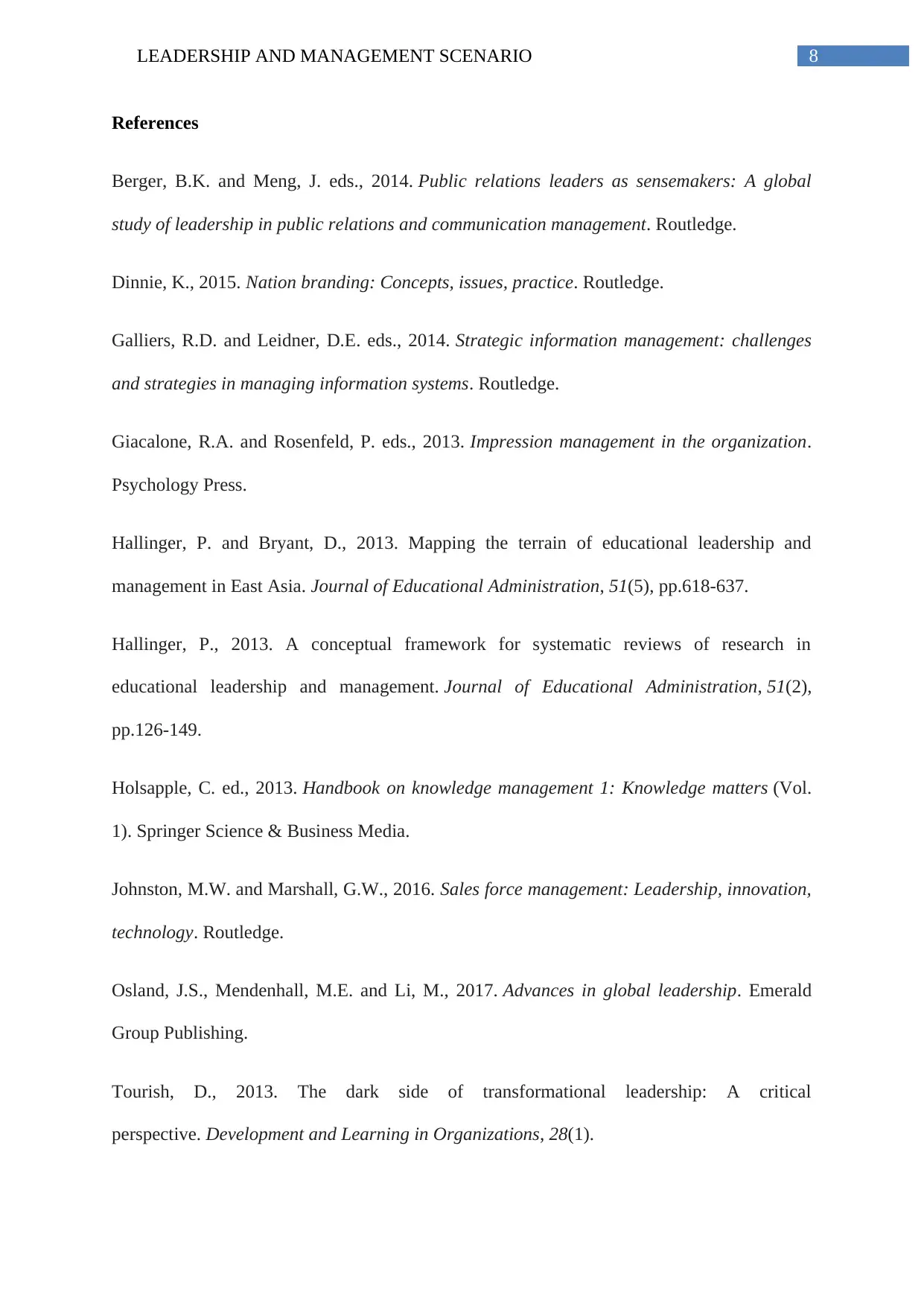
8LEADERSHIP AND MANAGEMENT SCENARIO
References
Berger, B.K. and Meng, J. eds., 2014. Public relations leaders as sensemakers: A global
study of leadership in public relations and communication management. Routledge.
Dinnie, K., 2015. Nation branding: Concepts, issues, practice. Routledge.
Galliers, R.D. and Leidner, D.E. eds., 2014. Strategic information management: challenges
and strategies in managing information systems. Routledge.
Giacalone, R.A. and Rosenfeld, P. eds., 2013. Impression management in the organization.
Psychology Press.
Hallinger, P. and Bryant, D., 2013. Mapping the terrain of educational leadership and
management in East Asia. Journal of Educational Administration, 51(5), pp.618-637.
Hallinger, P., 2013. A conceptual framework for systematic reviews of research in
educational leadership and management. Journal of Educational Administration, 51(2),
pp.126-149.
Holsapple, C. ed., 2013. Handbook on knowledge management 1: Knowledge matters (Vol.
1). Springer Science & Business Media.
Johnston, M.W. and Marshall, G.W., 2016. Sales force management: Leadership, innovation,
technology. Routledge.
Osland, J.S., Mendenhall, M.E. and Li, M., 2017. Advances in global leadership. Emerald
Group Publishing.
Tourish, D., 2013. The dark side of transformational leadership: A critical
perspective. Development and Learning in Organizations, 28(1).
References
Berger, B.K. and Meng, J. eds., 2014. Public relations leaders as sensemakers: A global
study of leadership in public relations and communication management. Routledge.
Dinnie, K., 2015. Nation branding: Concepts, issues, practice. Routledge.
Galliers, R.D. and Leidner, D.E. eds., 2014. Strategic information management: challenges
and strategies in managing information systems. Routledge.
Giacalone, R.A. and Rosenfeld, P. eds., 2013. Impression management in the organization.
Psychology Press.
Hallinger, P. and Bryant, D., 2013. Mapping the terrain of educational leadership and
management in East Asia. Journal of Educational Administration, 51(5), pp.618-637.
Hallinger, P., 2013. A conceptual framework for systematic reviews of research in
educational leadership and management. Journal of Educational Administration, 51(2),
pp.126-149.
Holsapple, C. ed., 2013. Handbook on knowledge management 1: Knowledge matters (Vol.
1). Springer Science & Business Media.
Johnston, M.W. and Marshall, G.W., 2016. Sales force management: Leadership, innovation,
technology. Routledge.
Osland, J.S., Mendenhall, M.E. and Li, M., 2017. Advances in global leadership. Emerald
Group Publishing.
Tourish, D., 2013. The dark side of transformational leadership: A critical
perspective. Development and Learning in Organizations, 28(1).
⊘ This is a preview!⊘
Do you want full access?
Subscribe today to unlock all pages.

Trusted by 1+ million students worldwide
1 out of 9
Related Documents
Your All-in-One AI-Powered Toolkit for Academic Success.
+13062052269
info@desklib.com
Available 24*7 on WhatsApp / Email
![[object Object]](/_next/static/media/star-bottom.7253800d.svg)
Unlock your academic potential
Copyright © 2020–2025 A2Z Services. All Rights Reserved. Developed and managed by ZUCOL.





